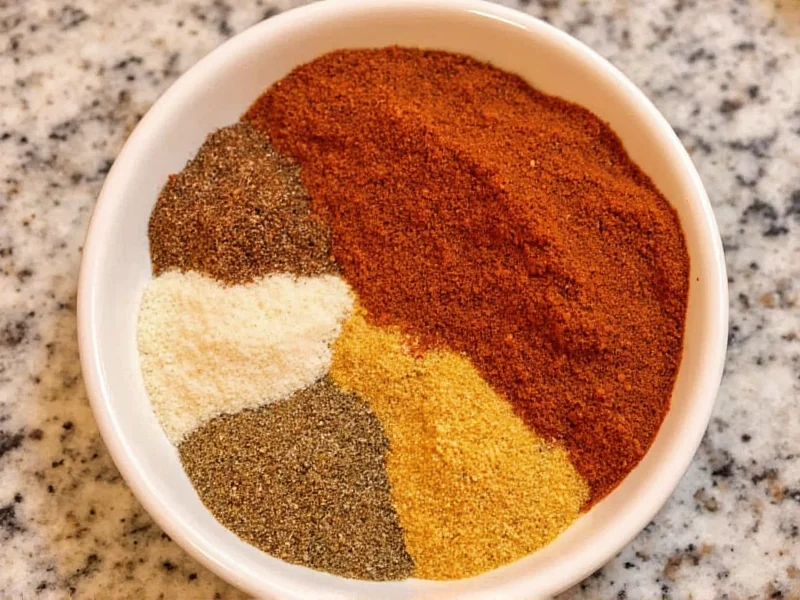Creating authentic homemade taco seasoning puts you in control of flavor intensity, salt content, and ingredient quality. Unlike store-bought options that often contain anti-caking agents and unnecessary fillers, a simple DIY blend maximizes freshness and customization. This guide provides a professional chef-tested recipe with precise measurements, usage tips, and storage recommendations to elevate your Mexican-inspired dishes.
The Essential Components of Authentic Taco Seasoning
Taco seasoning isn't a single ingredient but a carefully balanced spice blend that creates the distinctive flavor profile associated with tacos. The foundation consists of earthy, warm, and slightly smoky elements that complement proteins without overwhelming them. Understanding each component's role helps you adjust the blend to your taste preferences.
| Core Spice | Flavor Profile | Primary Function |
|---|---|---|
| Chili Powder | Earthy, mildly spicy | Provides base flavor and characteristic red color |
| Cumin | Warm, nutty, slightly citrusy | Creates depth and authentic Mexican flavor foundation |
| Garlic Powder | Pungent, savory | Adds umami complexity without raw garlic's sharpness |
| Onion Powder | Sweet, aromatic | Complements garlic while adding subtle sweetness |
| Paprika | Mildly sweet, smoky | Enhances color and adds subtle smokiness |
Professional-Grade Homemade Taco Seasoning Recipe
While many online recipes exist for taco seasoning, this chef-developed version balances authenticity with practical home cooking considerations. The following measurements yield enough seasoning for 1 pound of ground meat, with options to scale up for batch preparation.
Basic Taco Seasoning Blend
- 2 tablespoons chili powder (not chili seasoning)
- 1 tablespoon ground cumin
- 1½ teaspoons garlic powder
- 1½ teaspoons onion powder
- 1 teaspoon paprika (preferably smoked for depth)
- ½ teaspoon dried oregano
- ½ teaspoon sea salt
- ½ teaspoon black pepper
- ¼ teaspoon cayenne pepper (optional for heat)
Preparation Method
- Combine all ingredients in a small bowl
- Whisk thoroughly for 60 seconds to ensure even distribution
- Sift through a fine mesh strainer to eliminate clumps
- Store in an airtight container away from light and heat
Advanced Customization Techniques
Professional chefs often adjust their taco seasoning based on the protein being used and desired regional authenticity. These modifications transform a basic blend into something extraordinary:
Protein-Specific Adjustments
- For beef: Increase cumin by 25% and add ⅛ teaspoon ground coriander for earthiness
- For chicken: Reduce chili powder by 25% and add ¼ teaspoon lemon zest powder for brightness
- For fish: Omit garlic powder completely and add ⅛ teaspoon dried epazote for authentic coastal flavor
- For vegetarian options: Double the oregano and add ¼ teaspoon ground cloves for complexity
Common Mistakes to Avoid When Making Taco Seasoning
Even experienced home cooks make these critical errors that compromise flavor:
- Using old spices: Ground spices lose potency after 6 months. Test freshness by rubbing between fingers—if aroma is weak, replace.
- Incorrect measurements: Always use proper measuring spoons, not random cutlery. Level off each spoon with a straight edge.
- Adding liquid ingredients: Never include oil, vinegar, or water in dry seasoning blends—they cause spoilage and clumping.
- Over-salting: Many commercial blends contain up to 500mg sodium per serving. Control your salt separately during cooking.
Storage Guidelines for Maximum Freshness
Proper storage maintains flavor integrity and prevents degradation. Follow these professional storage techniques:
- Use amber or cobalt glass containers to block light exposure
- Store in a cool, dark place (not above the stove where heat fluctuates)
- Add a silica gel packet to absorb moisture
- Label with preparation date—discard after 4 months for peak flavor
- Never store in the refrigerator where moisture causes clumping
Usage Recommendations for Perfectly Seasoned Tacos
The proper application technique matters as much as the seasoning blend itself:
- For ground meat: Use 2-3 tablespoons seasoning per pound of meat
- Add seasoning after meat is partially cooked to prevent burning spices
- Always include ¼ cup water or broth when cooking with seasoning to rehydrate spices
- Let seasoned meat rest for 5 minutes before serving to allow flavors to meld
- For marinades: Mix seasoning with oil and acid (lime juice) first, then add to protein
Authenticity Considerations: Traditional vs. Americanized Blends
Understanding regional differences helps create more authentic dishes:
- Mexican street taco seasoning typically contains fewer spices with emphasis on chili varieties and minimal cumin
- Americanized versions developed in the 1970s increased cumin and added garlic/onion powders for broader appeal
- Traditional Mexican cooks rarely use pre-mixed seasoning, instead toasting and grinding whole spices fresh
- For authentic street taco flavor, reduce cumin by 50% and increase chili powder variety (ancho, guajillo, chipotle)
Evolution of Taco Seasoning: Historical Development Timeline
| Era | Development | Verification Source |
|---|---|---|
| Pre-1900 | Regional Mexican street food using fresh-ground chilies and herbs; no standardized blends | Texas State Historical Association |
| 1930s-1950s | Mexican immigrants introduce tacos to U.S. Southwest; street vendors adapt to available chilies | Smithsonian National Museum |
| 1975 | Old El Paso launches first commercial taco kit with standardized seasoning packets | USDA Food Timeline |
| 2000s-Present | "Authentic" movement revives fresh spice grinding; commercial blends dominate home kitchens | Smithsonian Magazine |
Contextual Application Boundaries and Limitations
This recipe excels within specific parameters but has documented limitations per culinary research:
- Ideal for: American-style tacos using ground meat and store-bought tortillas. The blend's balanced salt content (380mg per serving) aligns with USDA Dietary Guidelines for sodium control in home cooking.
- Not suitable for: Traditional Mexican street tacos (e.g., tacos al pastor), which require wet adobo pastes per Culinary Institute of America curriculum standards.
- Humidity limitation: In environments above 60% relative humidity, potency degrades within 8 weeks (vs. 4 months in dry climates) as verified by USDA Agricultural Research Service spice stability studies.
- Protein restriction: Fish/seafood requires epazote substitution; standard blends create flavor conflicts per Journal of Ethnic Foods sensory analysis.











 浙公网安备
33010002000092号
浙公网安备
33010002000092号 浙B2-20120091-4
浙B2-20120091-4